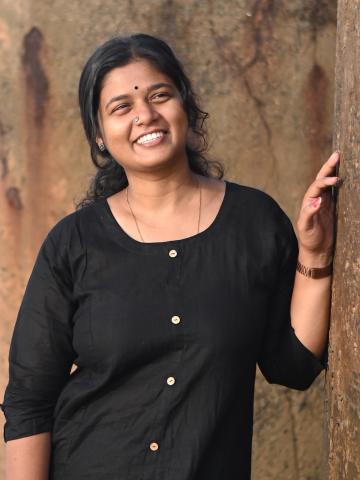
IAMCR is pleased to announce that the 2025 Urban Communication Awards will be given to three papers that develop and explore innovative approaches to urban communication. The award-winning papers are:
- “Sense of Place in Manhattan Chinatown under Urbanization and Multiculturalism: Voices from Tourists and Residents", Miao Chu, Xi’an Jiaotong University (China), and Connie Yuan, Cornell University (USA)
- “Is the Air-Conditioner a Screen?", Hui Wong, McGill University (Canada)
- “Spatial Practices of Girl Children in Chennai’s Resettlement Areas through Photovoice", Krishna Priya, Mizoram University (India)
The awards will be formally presented at a special session during the IAMCR 2025 conference in Singapore.
Sense of Place in Manhattan Chinatown under Urbanization and Multiculturalism: Voices from Tourists and Residents
Submitted to the Diaspora and Media Working Group (DIM).

Miao Chu is a Ph.D. candidate in Journalism and Communication at Xi'an Jiaotong University. She has conducted research at Cornell University's Department of Communication and completed an internship there. Her research focuses on intercultural communication and urban/regional branding.

Connie Yuan is a full professor in the Department of Communication at Cornell University. She teaches and does research in the areas of organizational communication and intercultural communication. Her recent research examined how American and Chinese people react differently to climate change initiatives and how they obtain health information differently.
Abstract
This study examines the divergent sense of place between residents and tourists about Manhattan Chinatown, a historic ethnic enclave undergoing urbanization and multicultural commodification. Through mixed methods, including interviews, survey, ethnographic observations, and analysis of TripAdvisor reviews, this study constructs a two-tiered framework that bridges universal place dimensions (e.g., functionality, physical setting) with ethno-cultural specificities (e.g., unique cultural experiences, linguistic barriers). Analyses of marginalized residents’ narratives reveal how longstanding negligence of this community’s concerns and communication breakdowns exacerbate urban planning inequities such that local identity, economic survival, and tourist expectations intersect in complex ways. Concerns were raised about urban policies that prioritize multicultural branding over equitable development. These insights advocate for establishing multilateral communication to ensure comprehensive community participation in place-making processes. By comparing the perspectives of residents and tourists, this study advances a deeper understanding of inclusive urban planning that balances tourism economies with the well-being of the ethnic community.
Comment by the Selection Committee:
Miao Chu and Connie Yuan's paper is highly relevant for the field of urban communication studies, especially its focus on the resident-tourist struggle. The committee also appreciated the theoretical/multidimensional model used in the study.
Is the Air-Conditioner a Screen?
Submitted to the Visual Culture Working Group (VIC)

Hui Wong writes about infrastructure, psychoanalysis, and affect, and his research poses infrastructures as communicative psychic objects. Hui is particularly interested in infrastructures in Singapore. He holds an MA in Communication Studies from McGill University, and is an incoming Film & Media PhD student at the University of California, Berkeley.
Abstract
Is the air-conditioning unit, or more precisely, the assemblage that the air-conditioning unit demands, a screen? This paper argues that an affirmative answer is productive for thinking about a particularly generative link between Singaporean modernity, national identification, heat, and subjectivity. These four nodes are, as it were, “split” and drawn together by the air-conditioner as a technique and technology. This paper works from a speculative image: a Singaporean citizen, in a glass-walled building, looks outside and sees a hot street in which low-waged migrant workers work. Separated by a glass window, itself necessitated by (the functioning of) an air-conditioner, the citizen in a cooled space gazes outside at a “dematerialized” world: the air-conditioning and glass window isolate the visual from the other senses used to experience the climate. Far from being fictitious or a rare sight, however, this paper shows that the spatial, economic, political, thermal, and desirous situation in Singapore makes this image something of a trope: in regular parlance, a convention or cliché; in literary studies, a figure of speech, metaphor and metonymy (condensation and displacement).
Comment of the Selection Committee:
Hui Wong's focus on the materiality of the air-conditioner generates an original and innovative perspective on urbanity, raising questions that are at the same time broader than the particular object of the air-conditioner.
Spatial Practices of Girl Children in Chennai’s Resettlement Areas through Photovoice
Submitted to the Gender and Communication Section (GEN)

Krishna Priya is a PhD scholar in the Department of Mass Communication at Mizoram University. Her PhD research concerns with Communication and Spatial Practices in Everyday Lives of Women in Chennai’s Resettlement Areas. She explores her research area by employing qualitative and unconventional research methods such as Photo Voice. She has three years of experience teaching Mass Communication at Don Bosco College and Loyola College, Chennai. She is a leading member and performing artist in Muttram, a Performative Arts Association that works for voiceless marginalised communities.
Abstract
Lefebvre’s critique of urban space and the role of planners is deeply rooted in his understanding of space as a product of social relations, particularly under capitalism. The urban space has been increasingly gentrified to cause threats to the spaces of livelihood and habitats of the marginalised sections of the population. The resettlement areas in Chennai, the capital of Tamil Nadu highlight the marginalisation of Chennai’s indigenous communities, vital to the city’s development yet pushed to its fringes. Since 2000, urban beautification efforts have intensified their plight. The 2011 Census recorded 329,827 slums housing 1.34 million people—28.89% of Chennai’s population.
However, forced relocations to suburban areas have rapidly reduced this number in recent years. The oppressed and marginalised people in resettlement colonies like Kannagi Nagar and Ezhil Nagar, especially girl children face challenges in everyday life, through the change of space by forced eviction. The resettlement areas are the spaces where multiple ghettos are put together within a confined space, resulting in more oppression and marginalisation of girl children under the guise of safety and preventive measures. The family members fear the local boys and men who are on substance drug abuse and engage in violent behaviour. As a consequence of the resettlement areas, the spaces for girls are restricted. Everyday space is an uneven gendered process, often with girl children restricted to domestic spaces. Most girl children are not allowed to utilise public spaces like boys other than their homes. and their space is determined, regulated, and deliberately excluded by their parents and well-wishers. This study critically examines the impact of resettlement on girl children in Kannagi Nagar, focusing on their navigation of private and public Spatial Practices. Through a spatial analysis framework, this research explores how girl children accept and reproduce their own space.
Comment of the Selection Committee:
The committee appreciated Krishna Priya's innovative and societally relevant paper, and particularly enjoyed the photovoice material and its intersection with the logic of empowerment.
Urban Communication Award 2025 Selection Committee
- Janet Wasko, University of Oregon (USA), Chair
- Nico Carpentier, Charles University (Czech Republic)
- Yong-Chan Kim, Yonsei University (Seoul, Korea)
- Yiannis Christidis, Cyprus University of Technology (Cyprus)
- Cees Hamelink, University of Amsterdam (Netherlands)
- Deborah Philips, University of Brighton (UK)